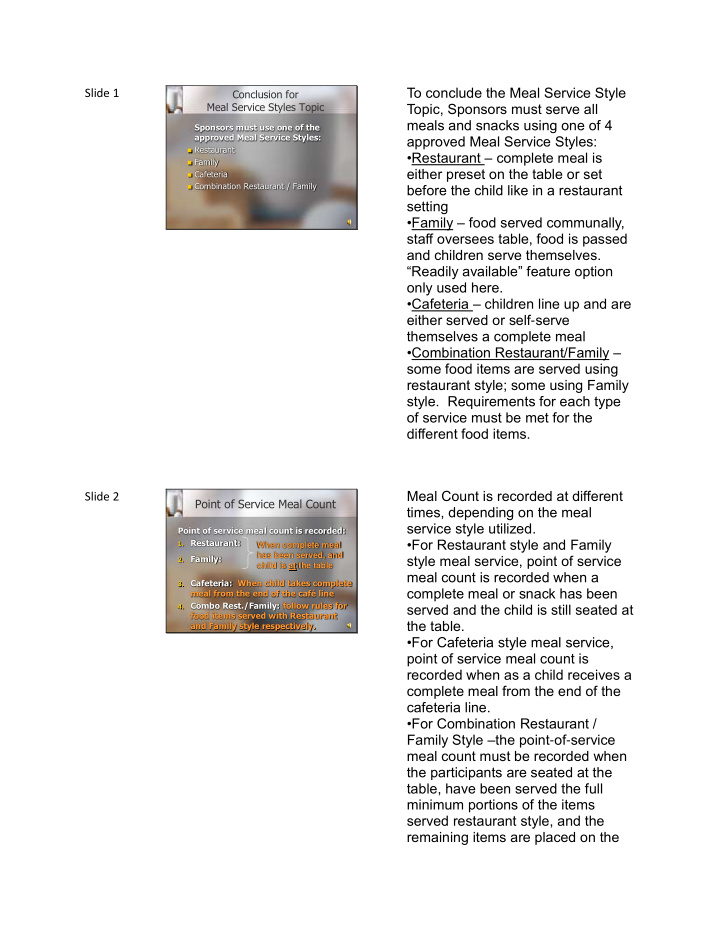



To conclude the Meal Service Style Slide 1 Conclusion for Meal Service Styles Topic Topic, Sponsors must serve all meals and snacks using one of 4 Sponsors must use one of the approved Meal Service Styles: approved Meal Service Styles: Restaurant •Restaurant – complete meal is Family either preset on the table or set Cafeteria Combination Restaurant / Family before the child like in a restaurant setting •Family – food served communally, staff oversees table, food is passed and children serve themselves. “Readily available” feature option only used here. •Cafeteria – children line up and are either served or self - serve themselves a complete meal •Combination Restaurant/Family – some food items are served using restaurant style; some using Family style. Requirements for each type of service must be met for the different food items. Meal Count is recorded at different Slide 2 Point of Service Meal Count times, depending on the meal service style utilized. Point of service meal count is recorded: 1. Restaurant: •For Restaurant style and Family When complete meal has been served, and 2. Family: style meal service, point of service child is at the table meal count is recorded when a 3. Cafeteria: When child takes complete complete meal or snack has been meal from the end of the café line 4. Combo Rest./Family: follow rules for served and the child is still seated at food items served with Restaurant the table. and Family style respectively. •For Cafeteria style meal service, point of service meal count is recorded when as a child receives a complete meal from the end of the cafeteria line. •For Combination Restaurant / Family Style –the point - of - service meal count must be recorded when the participants are seated at the table, have been served the full minimum portions of the items served restaurant style, and the remaining items are placed on the
table. The point - of - service “actual count” Slide 3 Actual Count vs. Head Count method records the reimbursable meals served to each participant, by Point of Service Meal Count Methods: name (first and last). Sponsors who Actual Count – records meals by serve more than two meals and one participant name snack or two snacks and one meal Head Count – records meals by are required to use the “actual counting the number of participants count” method. The Daily Meal receiving a reimbursable meal. Count - Actual Count Method form (Exhibit 23.16 in Big Red) is available to use or Sponsors may develop their own “actual count” form. • The point - of - service “head count” method tallies the meals by counting the number of participants receiving a reimbursable meal and documenting the number on the Daily Meal Count - Head Count Method (Exhibit 23.17 in Big Red) Either actual count or head count meal counting methods may be used with all the approved meal service styles. Refer to chapter 5 in Big red for more information on meal counting requirements.
The following are examples of meal count Slide 4 Common Errors – Meal Counting methods that are not acceptable: • Cou nting the number of meals prepared Examples of meal count methods that are or sent by the kitchen; NOT acceptable: • Determining the meal count by subtracting Counting # meals prepared by kitchen Subtracting # meals leftover from # the number of entrees left over after the meals prepared meal service from the number of entrees Counting # meals prepared by vendor prepared; Counting server’s memory or attendance records • Counting the number of meals ordered Counting # of plates or trays used from a vendor; • Counting meals after the meal is completed based on teachers’ memory or daily attendance records; and • Counting the number of trays or plates on which food is served. Do not count participants who were not served a creditable meal (for example, a participant who was served tofu as a Meat/Meat Alternate — their meal should not be counted for reimbursement). Have meal count forms readily available in the serving area. Meals served to teachers, helpers, and non-participant adults are not reimbursable and must not be reported on the monthly reimbursement claim. Keep meal count forms in a notebook or folder, or on a bulletin board or clipboard so they are easy for the meal count staff to find and record meal counts. Sponsors should verify the accuracy of the claim for reimbursement, compared to the meal count records. Utilizing correct meal service style Slide 5 Meal service style and Meal Count and recording meal count accurately at the point of service are important Meal service style and point of service Program features and are meal count are sometimes findings during important Program requirements. It’s administrative reviews. It’s important to know what style you use and important to know what style your at what point to record facility uses and at what point to meal count! record meal count.
Recommend
More recommend